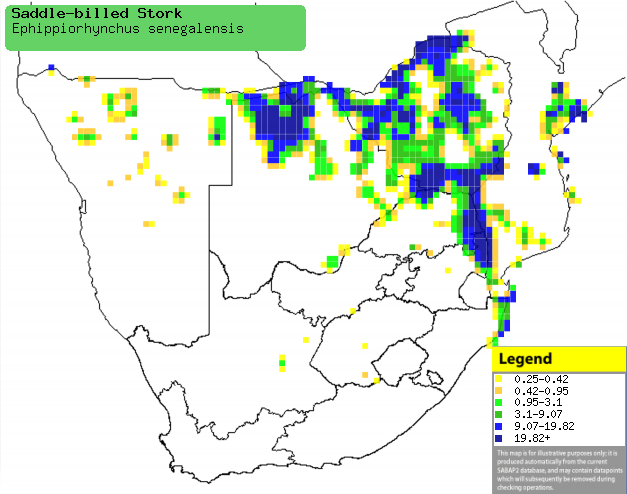|
Ephippiorhynchus senegalensis (Saddle-billed
stork)
Saalbekooievaar [Afrikaans];
Kandjendje [Kwangali]; Ngwamhlanga [Tsonga]; Zadelbekooievaar [Dutch]; Jabiru
d'Afrique [French]; Sattelstorch [German]; Jabiru [Portuguese]
Life
> Eukaryotes >
Opisthokonta
> Metazoa (animals) >
Bilateria >
Deuterostomia > Chordata >
Craniata > Vertebrata (vertebrates) > Gnathostomata (jawed
vertebrates) > Teleostomi (teleost fish) > Osteichthyes (bony fish) > Class:
Sarcopterygii (lobe-finned
fish) > Stegocephalia (terrestrial
vertebrates) > Tetrapoda
(four-legged vertebrates) > Reptiliomorpha > Amniota >
Reptilia (reptiles) >
Romeriida > Diapsida > Archosauromorpha > Archosauria >
Dinosauria
(dinosaurs) > Saurischia > Theropoda (bipedal predatory dinosaurs) >
Coelurosauria > Maniraptora >Aves
(birds) > Order: Ciconiiformes > Family: Ciconiidae
Distribution and habitat
Occurs across sub-Saharan Africa, largely excluding the
West African coast. In southern Africa, it is uncommon in northern
and eastern Botswana, northern Namibia (including the Caprivi Strip), Zimbabwe,
eastern South Africa and Mozambique. It generally prefers freshwater marshes,
rivers through open savanna, lake shores, pans and flood plains.
|
 |
|
Distribution of Saddle-billed stork in southern Africa,
based on statistical smoothing of the records from first SA Bird Atlas
Project (©
Animal Demography unit, University of
Cape Town; smoothing by Birgit Erni and Francesca Little). Colours range
from dark blue (most common) through to yellow (least common).
See here for the latest distribution
from the SABAP2. |
Movements and migrations
Resident and largely sedentary, although
juveniles often disperse far from their parents' territory to
temporary pans and vleis.
Food
It mainly eats fish, doing most of its foraging in shallow
water, standing still and taking animals that come within striking distance, or wading through water and stabbing prey. The following food items have been recorded
in its diet:
- Vertebrates
- fish
- Propterus (lungfish)
- Clarias (catfish)
- frogs
- reptiles
- small mammals
- birds
- Anas erythrorhyncha (Red-billed
teal)
- Invertebrates
Breeding
- Monogamous, strongly territorial solitary nester, with breeding pairs
probably staying together for life.
- The nest is built by both sexes, consisting of a large platform of
sticks and earth, with a central cup lined with grass or reeds. It is
typically placed on top of a tall or low tree in a swamp,
occasionally using the nest of another bird such as
Tawny eagle,
Wahlberg's eagle and
Secretarybird.
- Egg-laying season is almost year-round, peaking from August-March.
- It lays 2-4 eggs, which are incubated by both sexes for roughly 30-35
days, alternating in 1-6 hour shifts.
- The chicks are brooded by both parents for up to about 10 days, probably
leaving the nest at approximately 70-100 days old. They are fed by both adults, who also regurgitate water for
them to drink.
Threats
Not threatened globally, but it is Endangered in South
Africa and Swaziland and threatened in Mozambique.
References
-
Hockey PAR, Dean WRJ and Ryan PG 2005. Roberts
- Birds of southern Africa, VIIth ed. The Trustees of the John Voelcker
Bird Book Fund, Cape Town.
|
